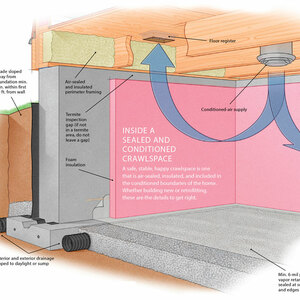Hole in Sheathing at bottom of Shower
Our Builder is almost ready to wrap up the Rough-In stage of our home and I found a hole in the exterior sheathing that looked like it was chisled out with a hammer at the bottom of our shower. In the pictures I’ve attached below, it looks like it might have been originally carved out to allow piping to reach the exterior, but this PVC goes straight down into the slab.
They’ve just delivered brick out there and I’m wondering whether I should raise this issue to plug it up with puddy or some such before they lay the brick. I felt around it and it’s trapped some moisture there as well.
Am I being too picky here? Is this something worth raising to the builder? I don’t want to hammer the builder with non-issue complaints but at the same time I don’t want to give vermin a way in or a way to allow mold to grow.
What do you think?
Thanks,
Drew






















Replies
One more Detail
The insulation for the home is going to be spray foam - not sure whether or not this will be sufficient to plug the cavity.
Drew
No harm in asking.
I suspect it was done by the plumber.
Yessir
Call.
If that's daylight off to the left and there is moisture there-neither should be and one probably caused the other.
The exterior shell has been compromised and should not just be "covered up".
This from a dumb carpenter.
One other thing comes to mind.
As I recall, shower and bath fixtures are typically insulated, vapor barriered, and installed at the framing phase. They can be a PITA to access once the house is finished. All the more reason to get this issue buttoned up now.
Yes Indeed!
The builder should adress this before brick work. Looks like yet another sloppy plumber caused problem. Sheathing could be replaced for a small patch are stud to stud there and then tarpaper over it ( lapped correctly) on the exterior.
Another repair would be to place a bit of AL metal flashing over the hole with tarpaper lapped over it, then use a can of spray faom on the inside to fill the space between PVC and the metal patch
Make sure the briklayers leave drainage slots at the base of the wall